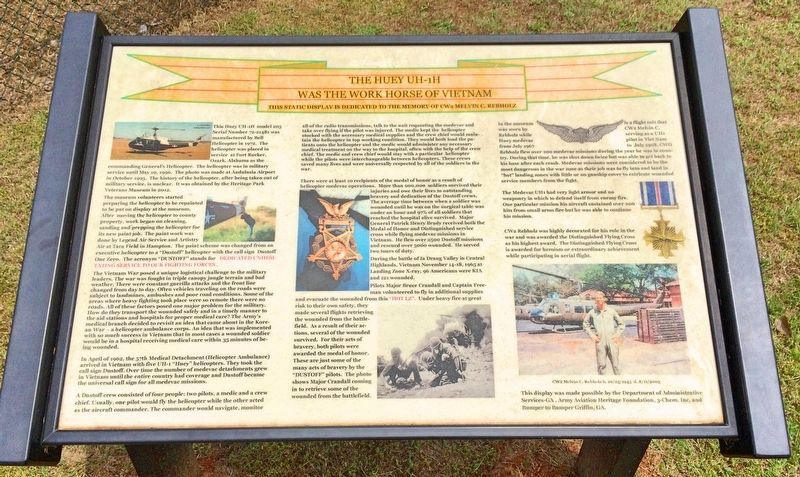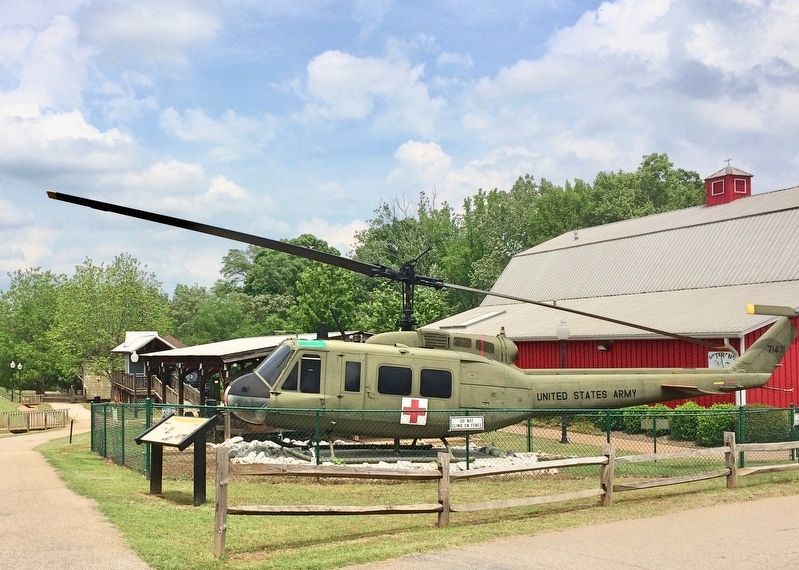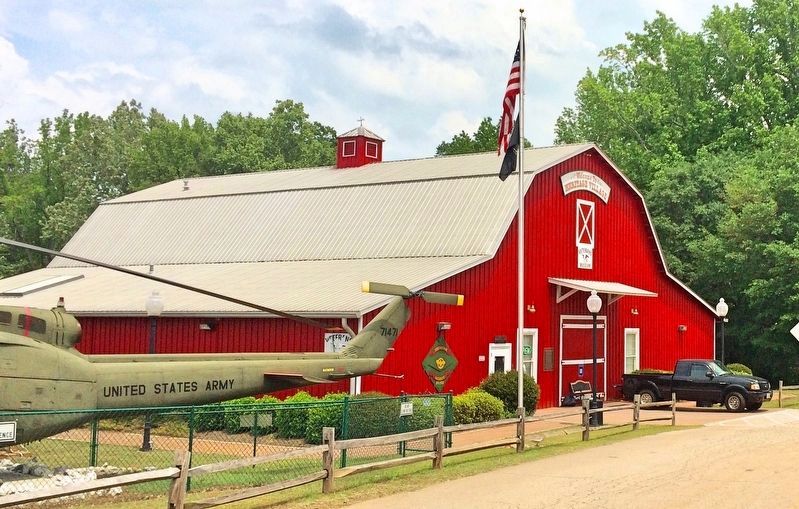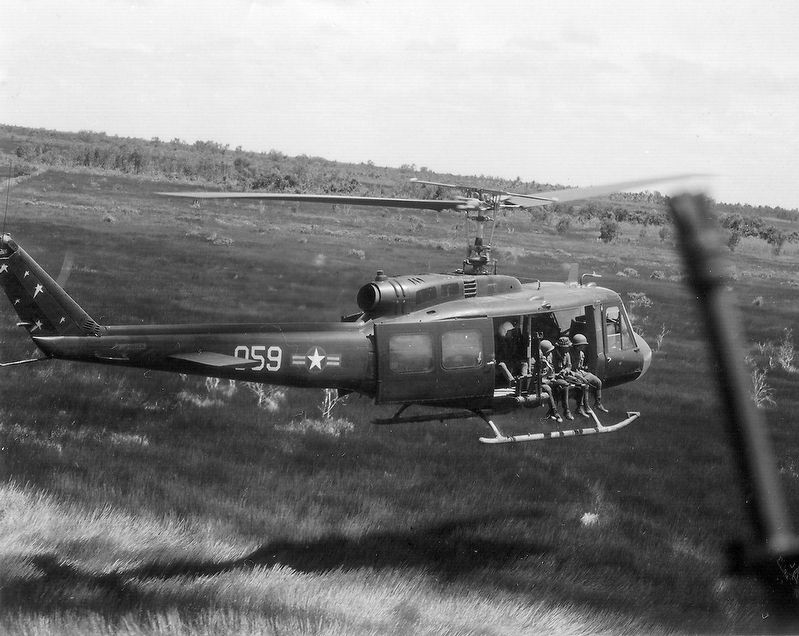McDonough in Henry County, Georgia — The American South (South Atlantic)
The Huey UH-1H Was the Work Horse of Vietnam
The museum volunteers started preparing the helicopter to be repainted to be put on display at the museum. After moving the helicopter to county property, work began on cleaning, sanding and prepping the helicopter for its new paint job. The paint work was done by Legend Air Service and Artistry Air at Tara Field in Hampton. The paint scheme was changed from an executive helicopter to a "Dustoff" helicopter with the call sign Dustoff One Zero. The acronym "DUSTOFF" stands for Dedicated Unhesitating Service to Our Fighting Forces.
The Vietnam War posed a unique logistical challenge to the military leaders. The war was fought in triple canopy jungle terrain and bad weather. There were constant guerilla attacks and the front line changed from day to day. Often vehicles traveling on the roads were subject to landmines, ambushes and poor road conditions. Some of the areas where heavy fighting took place were so remote there were no roads. All of these factors posed one major problem for the military. How do they transport the wounded safely and in a timely manner to stations and hospital for proper medical care? The Army's medical branch decided to revisit an idea that came about in the Korean War -- a helicopter ambulance corps. An idea that was implemented with so much success in Vietnam that in most cases a wounded soldier would be in a hospital receiving medical care within 35 minutes of being wounded.
In April of 1962, the 57th Medical Detachment (Helicopter Ambulance) arrived in Vietnam with five UH-1 helicopters. They took the call sign Dustoff. Over time the number of medevac detachments grew in Vietnam until the entire country had coverage and Dustoff became the universal call sign for all medevac missions.
A Dustoff crew consisted of four people: two pilots, a medic and a crew chief. Usually, one pilot would fly the helicopter while the other acted as the aircraft commander. The commander would navigate, monitor all of the radio transmissions, talk to the unit requesting the medevac and take over flying if the pilot was injured. The medic kept the helicopter stocked with the necessary medical supplies and the crew chief would maintain the helicopter in top working condition. They would both load the patients onto the helicopter and the medic would administer any necessary medical treatment on the way to the hospital, often with the help of the crew chief. The medic and crew chief would stay with a particular helicopter while the pilots were interchangeable between helicopters. These crews saved many lives and were universally respected by all of the soldiers in the war.
There were at least 10 recipients of the medal of honor as a result of helicopter medevac operations. More than 900,000 soldiers survived their injuries and owe their lives to outstanding bravery and dedication of the Dustoff crews. The average time between when a soldier was wounded until he was on the surgical table was under an hour and 97% of all soldiers that reached the hospital alive survived. Major General Patrick Henry Brady received both the Medal of Honor and Distinguished service cross {sic} while flying medevac missions in Vietnam. He flew over 2500 Dustoff missions and rescued over 5000 wounded. He served two tours of duty.
During the battle of Ia Drang Valley in Central Highlands, Vietnam November 14-18, 1965 at Landing Zone X-ray, 96 Americans were KIA and 121 wounded.
Pilots Major Bruce Crandall and Captain Freeman volunteered to fly in additional supplies and evacuate the wounded from this "Hot LZ". Under heavy fire at great risk
to their own safety, they made several flights retrieving the wounded from the battle field. As a result of their actions, several of the wounded survived. For their acts of bravery, both pilots were awarded the medal of honor. These are just some of the many acts of bravery by the "Dustoff" pilots. The photo shows Major Crandall coming in to retrieve some of the wounded from the battlefield.
In the museum is a flight suit that was worn by CW2 Melvin C. Rebholz while serving as a UH1 Huey medevac pilot in Viet Nam from July 1967 to July 1968. CWO Rebholz flew over 200 medevac missions during the year he was in country. During that time, he was shot down twice but was able to get back to his base after each crash. Medevac missions were considered to be the most dangerous in the war zone as their job was to fly into and land in "hot" landing zones with little or no gunship cover to extricate wounded service members from the fight.
The Medevac UH1 had very light armor and no weaponry in which to defend itself from enemy fire. One particular mission his aircraft sustained over 200 hits from small arms fire but he was able to continue his mission.
CW2 Rebholz was highly decorated for his role in the war and was awarded the Distinguished Flying Cross as his highest award. The Distinguished Flying Cross is awarded for heroism or extraordinary
achievement while participating in aerial flight.
Erected by Department of Administrative Services-GA, Army Aviation Heritage Foundation, 3-Chem, Inc. and Bumper to Bumper Griffin, GA.
Topics and series. This historical marker is listed in these topic lists: Air & Space • Science & Medicine • War, Vietnam. In addition, it is included in the Valor in Aerial Operations series list. A significant historical month for this entry is April 1962.
Location. 33° 26.467′ N, 84° 7.232′ W. Marker is in McDonough, Georgia, in Henry County. Marker can be reached from Heritage Park Trail north of Lake Dow Road. Located within the Heritage Park Historical Village. Touch for map. Marker is at or near this postal address: 101 Lake Dow Road, McDonough GA 30252, United States of America. Touch for directions.
Other nearby markers. At least 8 other markers are within 2 miles of this marker, measured as the crow flies. Miller's Saw Mill Replica (a few steps from this marker); Steam Locomotive (within shouting distance of this marker); Lane's Place (within shouting distance of this marker); Clements Log Cabin (within shouting distance of this marker); McDonough Public Library (about 300 feet away, measured in a direct line); Ola Schoolhouse (about 300 feet away); Detached Cookhouse (about 300 feet away); The Brown House (approx. 1˝ miles away). Touch for a list and map of all markers in McDonough.
Also see . . .
1. Wikipedia article on the Huey UH-1H helicopter. (Submitted on May 13, 2017, by Mark Hilton of Montgomery, Alabama.)
2. Wikipedia article on Casualty evacuation (Dustoff). (Submitted on May 13, 2017, by Mark Hilton of Montgomery, Alabama.)
Credits. This page was last revised on May 13, 2017. It was originally submitted on May 13, 2017, by Mark Hilton of Montgomery, Alabama. This page has been viewed 490 times since then and 24 times this year. Photos: 1, 2, 3, 4. submitted on May 13, 2017, by Mark Hilton of Montgomery, Alabama.



